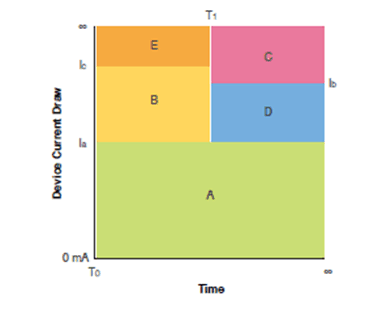SLVAEQ2 April 2020 TPS2549-Q1 , TPS254900-Q1 , TPS254900A-Q1 , TPS2556-Q1 , TPS2557-Q1 , TPS2559-Q1 , TPS25830-Q1 , TPS25831-Q1 , TPS25832-Q1 , TPS25833-Q1 , TPS25840-Q1 , TPS25842-Q1
-
How to Pass MFi Overcurrent Protection Test With USB Charger and Switch Device
- Trademarks
- 1 The Instruction of MFi OCP Requirement
- 2 Test Standard and Requirements
- 3
The Solution to Pass MFi OCP Test
- 3.1 Solution 1: Increasing Current Limit Point Higher Than 1.6*Ia
- 3.2
Solution 2: Paralleling RC With Rlimit to Delay the Current Limit Response
- 3.2.1 For the 1.5A USB Port With External FET
- 3.2.2 For the 1.5A Port Without External FET
- 3.2.3 For 2.1A USB Port With External FET
- 3.2.4 For 2.1A USB Port Without External FET
- 3.2.5 For 2.4A USB Port With External FET
- 3.2.6 For 2.4A USB Port Without External FET
- 3.2.7 For 3A USB Port With External FET
- 3.2.8 For 3A USB Port Without FET
- 4 Summary
- 5 References
1 The Instruction of MFi OCP Requirement
The section discusses the overcurrent and short circuit protection requirements. More information regarding Figure 1 and Table 1 through Table 3 can be found in the Overcurrent and Short Circuit Protection chapter of the Accessory Design Guidelines for Apple Device Specification.
 Figure 1. Overcurrent and Short Circuit Protection
Figure 1. Overcurrent and Short Circuit Protection Power-providing accessories must implement overcurrent and short circuit protection for each region as listed in Table 1 through Table 3.
Table 1. Overcurrent/Short Circuit Protection Current Thresholds
| Threshold | Definition |
|---|---|
| Ia | Nominal accessory output current (1000 mA, 2100 mA, 2400 mA, 3000 mA) |
| Ib | Ia + 60% |
| Ic | Lowest device current draw that causes accessory output voltage (measured at Lightning Device Power) to drop below 2 V. |
Table 2. Overcurrent/Short Circuit Protection Time Thresholds
| Threshold | Definition |
|---|---|
| T0 | Start of any device current draw transient. |
| T1 | Accessory overcurrent/short circuit deglitch/debounce time, must ≥ T0 + 1 ms. |
Table 3. Overcurrent/Short Circuit Protection Time Thresholds
| Threshold | Name | Definition |
|---|---|---|
| A | Normal Operation | Accessory must not limit or shutdown output current. |
| B | Overcurrent Transient | Accessory must not shutdown output current. Accessory may limit output current to Ia or higher. |
| C | Overcurrent | Accessory must shut down output current. |
| D | Potential Overcurrent | Accessory must shut down output current. |
| E | Portential Short Circuit | If Lightning Device Power voltage drops below 2 V, the accessory may trigger short circuit protection. Accessories must not trigger short circuit protection on device current draw. |
The above descriptions divide different load conditions into several regions and indicate the accessory behavior of different regions. The problems faced by customers in the certification process are mainly related to region B. Region B is an overcurrent transient region that needs the accessory to not shut down the output current during .1 ms overcurrent load.